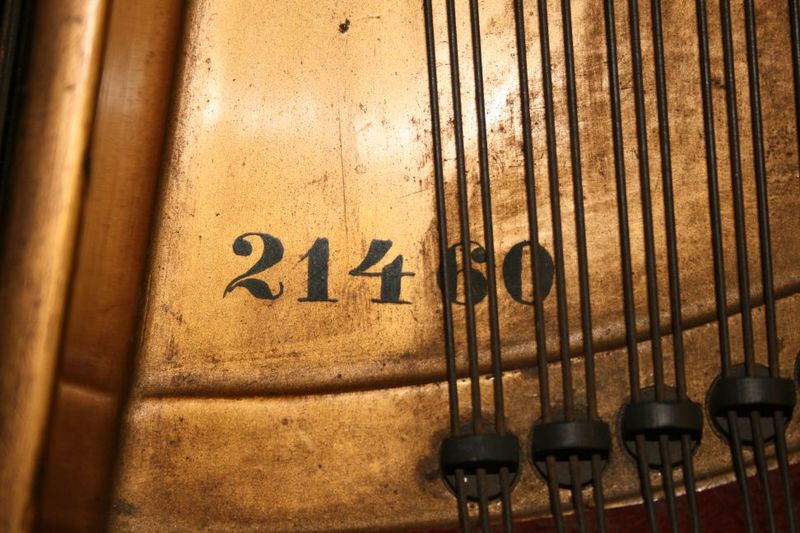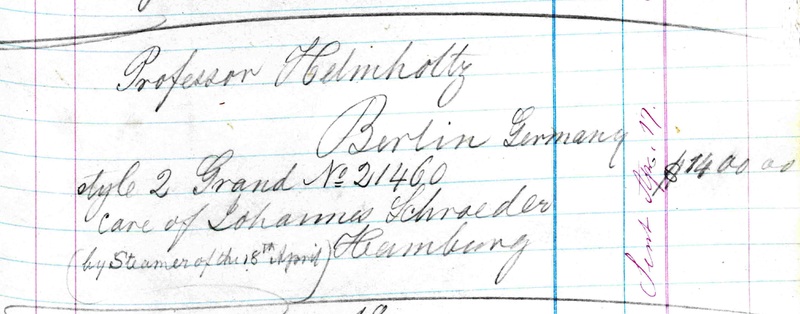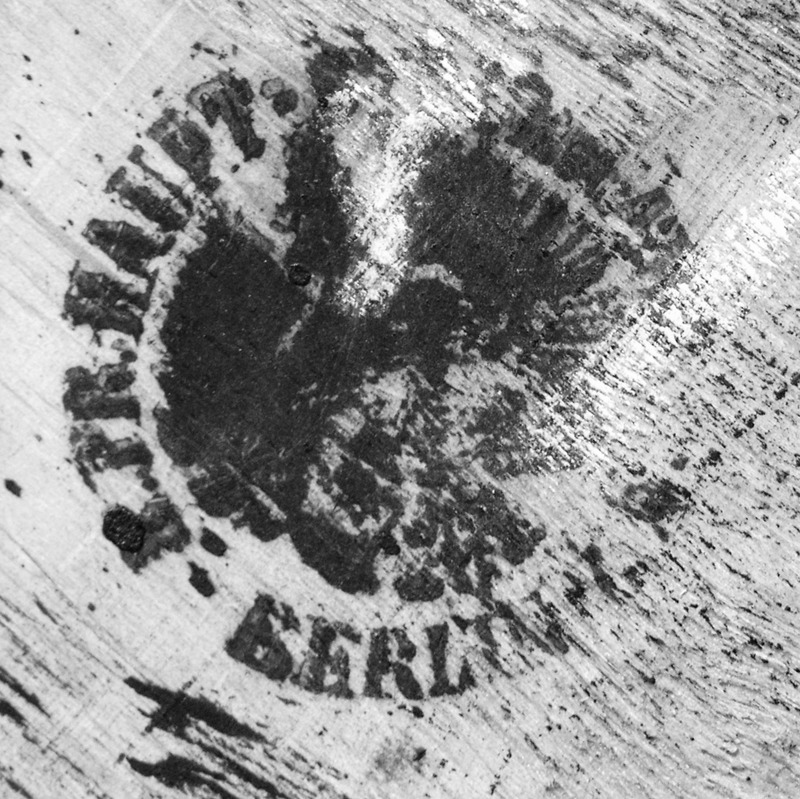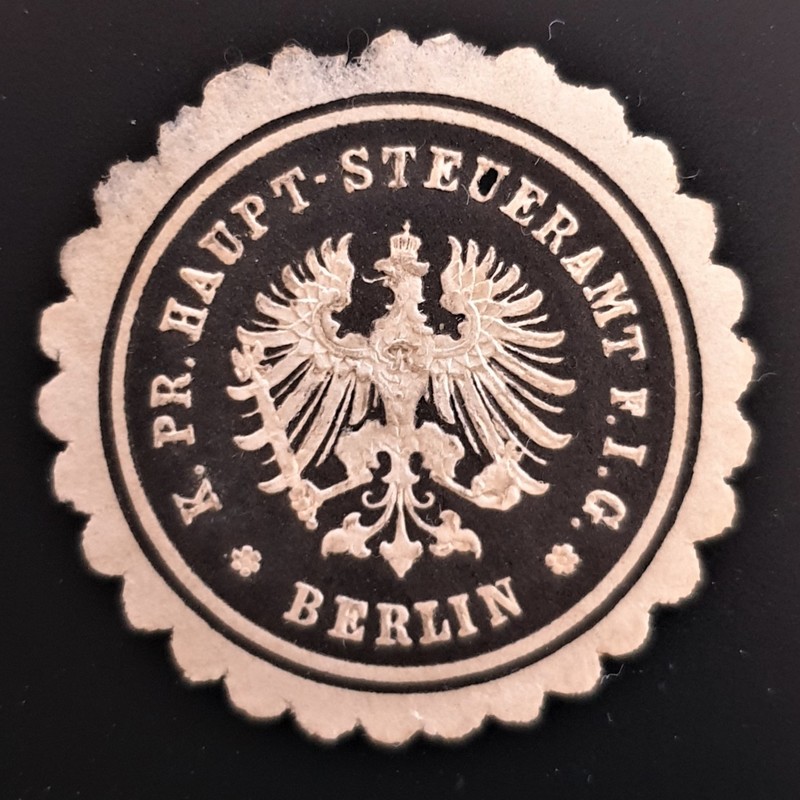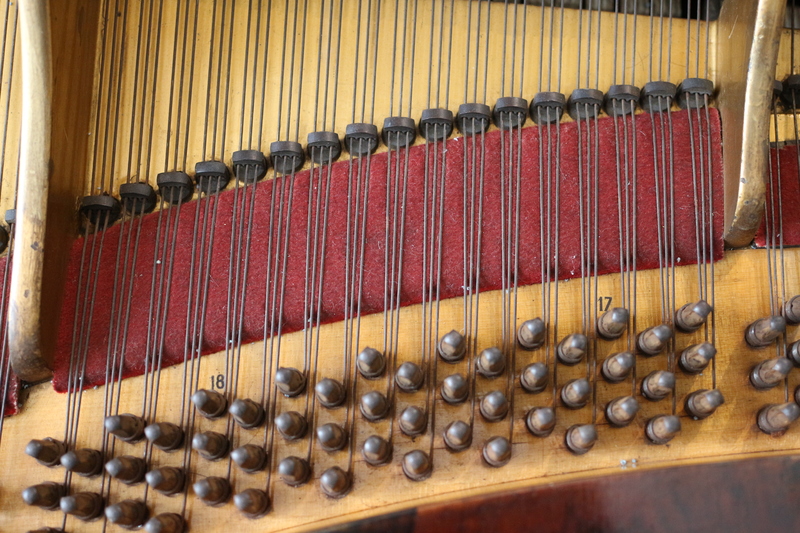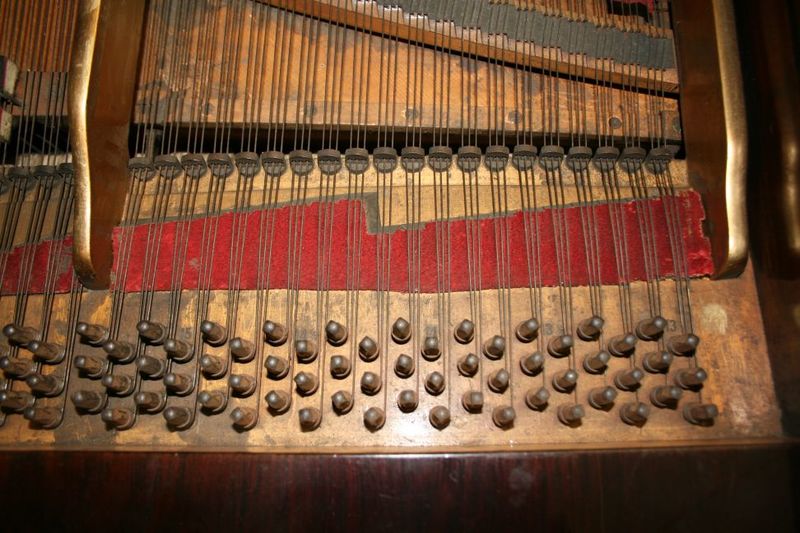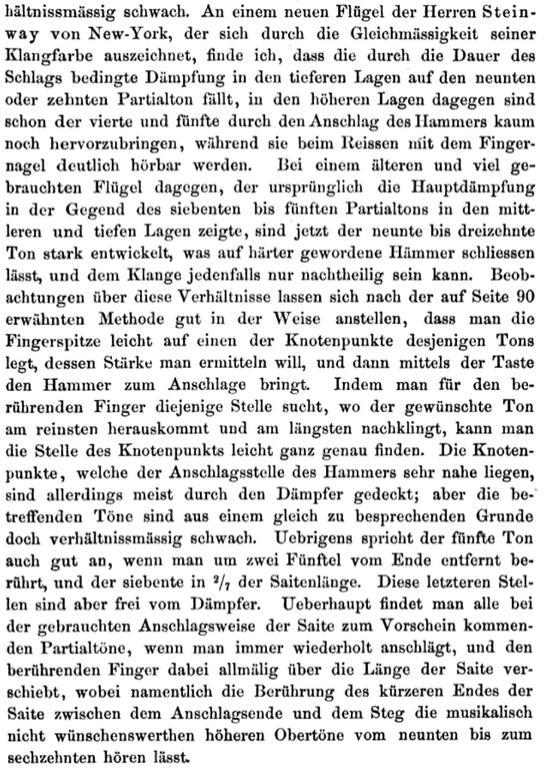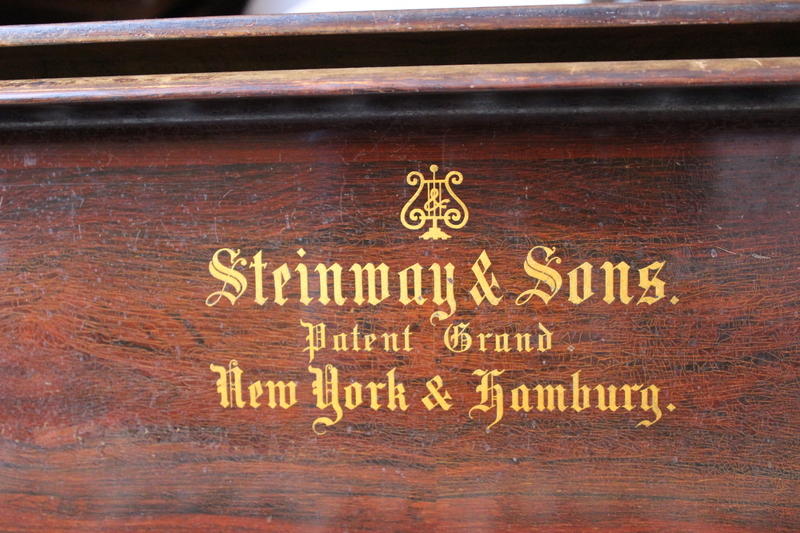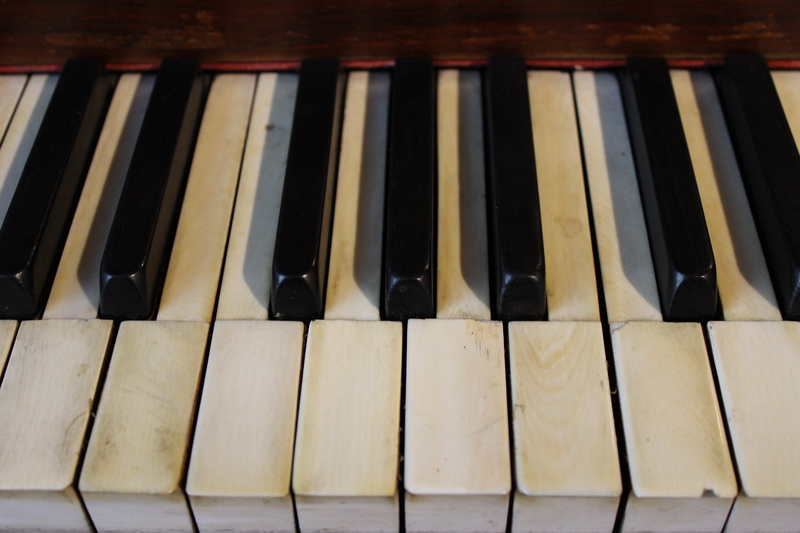Object Biography
Steinway & Sons sent a number of instruments to famous people. Their positive judgments were printed in advertising catalogs, which greatly contributed to the company’s increasing popularity. Most of the recipients were composers and virtuosos such as Richard Wagner and Franz Liszt, but various nobles were also among the lucky ones. It was unusual for a scientist like Helmholtz to be included in this list. But not only that – Helmholtz gradually became the recipient of three Steinway grand pianos. The earliest of these is now in the Deutsches Museum .[1]
How Helmholtz came to this instrument gives us a better understanding of the relationship between the researcher and the piano builders.
Fortunately, we know much about the “object biography” of the Helmholtz grand, i.e. the history of its use and the structural adjustments made to it after its completion in the factory. Our knowledge comes from indications on the instrument such as stamps, marks, or traces of wear; written documents such as company books, letters or diary entries also supplement our information. The following timeline lists our sources, together with comments.[2]
The Steinway family wrote to Hermann von Helmholtz announcing the dispatch of a concert grand piano as well as William Steinway’s forthcoming European tour.[3] The letter also informs us that Theodore Steinway, William’s brother and technical director of the company, had held several discussions with Helmholtz the previous year. This personal contact was probably the reason for sending the researcher an instrument. In addition, Helmholtz was just then moving to Berlin to accept the renowned physics professorship at Friedrich-Wilhelms-Universität. This finally thrust Helmholtz – who would turn 50 this year – into the upper echelons of international science.
New York, March 11, 1871
Professor Helmholtz
Heidelberg.
My dear sir,
We are in possession of your kind letter. First of all, please be assured that we are very honored by your order and will be happy to send a large concert grand piano for your disposal, at our expense.
The instrument has a range of 7 ¼ octaves and split dampers. The lowest 17 tones are lifted extra by a hammer, whereby the harmonic overtones of strings other than those struck allow each individual tone to resonate very concordantly. (To these ends, Zachariä in Frankfurt has invented a very ingenious but very complicated pedal system) [Note: this refers to piano maker Eduard Zachariä with his “artistic pedal”; see his publication Vollständige Kunstpedal-Schule, Frankfurt a. M. 1869]
As soon as this small device is ready, we will send the instrument to the freight forwarding business of
[v.]
Mr. Johannes Schroeder in Hamburg; we kindly ask you to send him your Berlin address. At your request, Hof Pianoforte Manufacturer Bechstein will be happy to unpack and set up the instrument for you.
If you approve of the instrument and wish to own it, the price is absolutely irrelevant and will play no role – for one, because you have done so much useful work for us on the sensation of tone and more importantly, because we hope this piano will inspire you to make even more valuable discoveries in the realm of tone.
Our Mr. William Steinway will probably arrive in Berlin in May and would be happy to make your acquaintance.
With the best greetings from our Mr. Theodore Steinway, who still remembers with great pleasure the stimulating conversations he had with you last year, we remain your
respectful and devoted servants.
Steinway & Sons
Entry in the Sales Book[4] documenting dispatch of the grand piano on April 17th followed by shipment to Hamburg by steamer on April 18th. There, it was received by the forwarding agent mentioned in the letter above, Johannes Schroeder. He organized its further transport to Helmholtz in Berlin.
The definite identification of the grand piano in the Sales Book of the Steinway company is enabled by the serial number 21460. This number is found on various parts of the instrument.
Diary entries by William Steinway concerning the shipment of the grand piano from New York to Berlin and its customs clearance. William Steinway himself was on a European tour that spring and summer. During a stopover in Berlin he wanted to visit Helmholtz, but the latter was not at home. Steinway at least learned from Helmholtz’s wife, however, that the grand piano had already arrived.
Excerpts from William Steinway’s diary concerning the grand piano:
May 25: "See Prof. Helmholtz wife, then Bechstein, our grand had just arrived."[5]
June 23: "call on Bechstein, receive about 5 Thlrs from him after deducting about 20 Thlrs duty for Helmholtz Grand"[6]
The Berlin piano maker Carl Bechstein had apparently handled the customs formalities on site. From the letter dated March 11th, it is apparent that Bechstein was to unpack and set up the new instrument. This is an interesting indication of the occasional collaboration between the two competitors.
The grand piano itself contains a stamp by the “Königlich-Preußisches Haupt-Steuer-Amt für inländische Gegenstände Berlin” [Royal Prussian Main Tax Office for Domestic Objects Berlin], which probably refers to the instrument’s customs clearance on arrival in Berlin.
In a letter to Theodore Steinway, Helmholtz thanked him for the grand piano and praised its qualities.[7]
1871. Helmholtz Mr. ___
Berlin, June 9, 1871
Dear Sir,
I would like to take this opportunity to thank you most sincerely for the very excellent grand piano you have sent me, which has now safely arrived at my home. I am amazed at the duration of the tone, which really gives the instrument a sound similar to that of an organ; at the lightness and delicacy of the touch with its great power; and at the precise and complete extinction of the tone by the damping, which is an essential element for clarity of play. The long strings of the lowest octave greatly improve the musical recognition of the bass tones. On typical instruments, the too short and greatly
[v.]
strained bass strings produce disharmonious overtones, giving the bass something bottle-like and muddying its musical intervals.
Such an instrument compels me to modify some of the judgments I have previously made about the piano. I often hear combination tones, and such a sustained tone as that on your grand piano is less sensitive (against mistuning) than that of instruments [whose sound] usually fades faster.
I am beginning to believe that it would be a substantial gain to give such an instrument just intonation in some keys. This could perhaps be done using a similar system as with the pedal harp, without an overly complicated mechanism. Would you be interested in having one of your instruments tuned for one key and then comparing the sounds of chords and short pieces of music with no modulations
[f2r.]
to [the same chords and musical pieces] on an instrument tuned in equal temperament? This could be easily accomplished and would provide an idea of the advantages of adapting to just intonation.
I find the split damper pedal action extremely beneficial for the kind of music I like to play, that is, pieces by Bach; I don’t know whether people who primarily play modern pieces will understand what it can do.
Unfortunately, I was not able to meet your brother here myself, but he promised my wife to return, and I hope to meet him then.
Once again with my best thanks,
Your
H. Helmholtz
In the 1872 sales catalog, Steinway preceded this letter with an interesting remark on the use of the grand piano. [8]
"A MOST valuable distinction has been received by Steinway & Sons, in that conferred on their pianos by Professor Helmholtz, who occupies the Chair of Acoustics in the Unversity of Berlin, and who is unanimously admitted to be the highest authority in the science of acoustics that is known.
The various improvements made by Steinway & Sons in their pianos, namely – the Patent Resonator, (by means of which the tension of the sound-board can be regulated with the greatest nicety,) and other important inventions introduced by them, all tending to obviate previously existing defects in all pianos, struck the Professor's attention, and, after a careful examination of the Steinway Pianos, and those of other makers, he arrived at the conclusion that the Steinway piano alone reached the acme of perfection, and he directed the purchase of a Steinway grand piano for express use for his experiments and lectures on acoustics in the Berlin University. [Es folgt die englische Übersetzung des Briefs vom 9. Juni 1871]"
Accordingly, Helmholtz had ordered the instrument for experiments and lectures on acoustics at the Friedrich-Wilhelms-Universität. However, the truth of this statement is doubtful, as it also falsely states that Helmholtz held a professorship for acoustics in Berlin. At least some of this information seem to be exaggerated for advertising purposes in order to emphasize the relevance of a positive judgment by Helmholtz as the “highest authority in acoustic science”.[9]
With the duplex scale, Steinway patented a design closely based on Helmholtz’s research. But it was one year too late to be included in the scientist’s grand piano – at least for the time being.
For several days, Theodore Steinway personally visited Helmholtz in Berlin with a Steinway foreman to “retrofit” Helmholtz’s grand piano with the duplex scale. This is attested to in a letter written by Helmholtz to his wife.[10] The results of the unusual conversion can also be seen on the instrument itself. Two photos illustrate this process.
Helmholtz described the retrofitting as follows:
My dear Anna,
Berlin, August 1, 1873.
[...]
In the morning, Mr. Theodore Steinway arrived and wished to apply his latest improvement [i.e. the duplex scale] to the high strings of our grand piano, at least as far as possible on an older instrument. On the parts of the strings on the keyboard side that no longer sound, [i.e.] between the wrestplank and the agraffe, he has added a second bridge that separates parts of strings that add certain overtones to the whole string. He finished it today; one of his craftsmen worked on it for most of the day with he himself supervising it. The high notes, which had been somewhat dry up to now, really seem to have become fuller and more sonorous. He now wants me to write him a letter saying how I like this alteration.
The highest tones of our grand piano are certainly better; you can hear the difference when the released string sections are damped again. By the way, it is unbelievable what study and fine work goes into such a grand piano. Mr. Steinway has shown me many more details inside, but I will propose additional changes to him.
[…]
The previous letter shows that Theodore Steinway had asked Helmholtz to evaluate the duplex scale. Helmholtz complied with his request, thanking the Steinways in writing for the conversion.[11] They also printed Helmholtz’s letter in their catalogs.
Berlin, August 13, 1873.
Mr. Steinway and Sons
New York
My dear sirs,
I can only wish you luck with the great improvement you have achieved on your pianos by implementing the duplex scale. I have repeatedly and carefully studied the effect of this duplex scale, which is now installed in my Steinway piano, and find this improvement most surprising and beneficial, especially in the higher notes; for as good an instrument as my piano was before, the duplex scale has given it a more flowing, singing and harmonious sound. I consider the improvement to be much for the better, and believe it capable of being developed further, etc.
Your most devoted
H. Helmholtz.
Helmholtz revised his Sensations of Tone for the fourth edition. It was the last one to appear during his lifetime and included a new paragraph about some experiments on his instrument.[12] Anna von Helmholtz documented the experiments in April 1876: “Since he [Helmholtz] is on holiday, thank God, he is now preparing a new edition of [Sensations of Tone]. While I write, with him next to me, he has already enticed the most amazing sounds out of the piano.”[13]
Helmholtz received a second grand piano from Steinway.[14] The new model was significantly smaller and therefore more suitable for [living] rooms. Furthermore, after 14 years, the previous grand piano was no longer technically up to date because Steinway had made many new patented changes.
According to a company register, Helmholtz sent his older grand piano to the Steinway factory in Hamburg, which had first opened in 1880.[15] There, the instrument was probably prepared for resale and given the new company logo, which now included both production sites, not only New York only. From Hamburg, the grand piano was shipped to London.
Since 2009, the Helmholtz grand piano has belonged to the musical instrument collection of the Deutsches Museum in Munich.[16] It will be exhibited in the new permanent Musical Instruments exhibition. Although playable, the instrument has deliberately not undergone complete restoration in order to preserve historical information. Instruments found in their largely original condition are relatively rare. This makes the Helmholtz-Steinway grand piano particularly interesting for researchers.
[1] Steinway & Sons, New York 1871, Ser. No. 21460, Inv. No. 2009-477: https://digital.deutsches-museum.de/item/2009-477/
[2] The documentation of the cited letters varies greatly. Some are available in archives in their original form, some are only available as excerpts in letter or catalog editions; the current whereabouts of others are unknown.
[3] This letter is part of the Helmholtz Archive in the Archive of the Berlin-Brandenburgischen Akademie der Wissenschaften, NL Helmholtz No. 448.
[4] New York, LaGuardia and Wagner Archives, Steinway & Sons Collection, Box No. 040330: Sales Book 1869-1871, p. 317.
[7] Letter from Hermann Helmholtz, dated Berlin, June 9, 1871. The addressee is not named, but from the context it must refer to Theodore Steinway, because Helmholtz regrets not personally having met “your brother”, i.e. William Steinway, when he had passed through. Originally preserved in New York, LaGuardia and Wagner Archives, Steinway & Sons Collection, Box No. 040260, Folder 67, Letter 01.
[8] Illustrated Catalogue of Steinway & Sons' Pianos, New York 1872, p. 28.
[9] Ibid.
[10] Letter from Hermann von Helmholtz to his wife Anna, dated Berlin, August 1, 1873,
printed in: Ellen von Siemens-Helmholtz (ed.), Anna von Helmholtz. Ein Lebensbild in Briefen, Vol. 1, Berlin 1929, p. 186.
[11] The presumably German-language original of this letter can no longer be found. This excerpt is taken from an article by Theodore Steinway for “Signale für die musikalische Welt”. The letterhead was translated into English for the Steinway catalogs.
[12] Helmholtz: Sensations of Tone, 4th edition (1877) p. 131.
[13] Letter from Anna von Helmholtz, addressee unknown, dated Berlin, April 4, 1876,
printed in: Ellen von Siemens-Helmholtz (ed.): Anna von Helmholtz. Ein Lebensbild in Briefen, Vol. 1, Berlin 1929, p. 203.
[14] Fostle, Don W.: The Steinway Saga. An American Dynasty, New York et al. 1995, p. 289.
[15] Washington DC, National Museum of American History - Smithsonian Institution, Archives Center, Steinway & Sons Records and Family Papers, 1857-1919, NMAH.AC.0178, Series 2, Steinway Business Records, 1858-1910, Serial number books for piano production, Book # 12-487-2000 thru 125999, Box 6, Reel 1, entry for serial number 21460 (no pagination) These are microfilms of the serial number books. The originals are owned by the company.
Citation: Katharina Preller, ‘“One of the most beautiful applications of science to art”? The Helmholtz grand piano by Steinway & Sons’, in: Materiality of Musical Instruments. A Virtual Exhibition.


